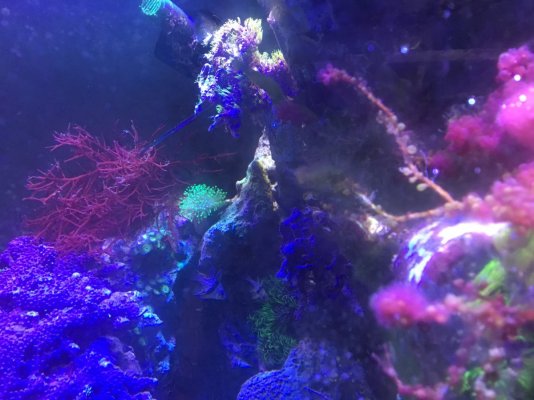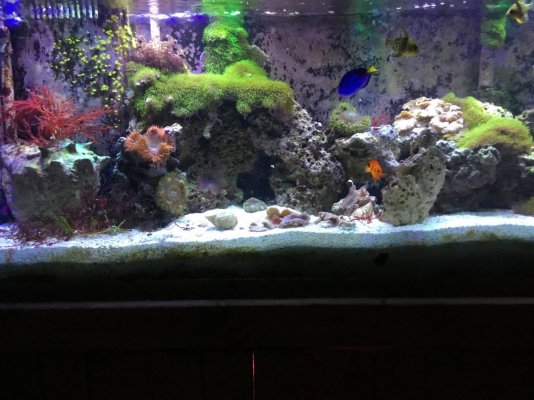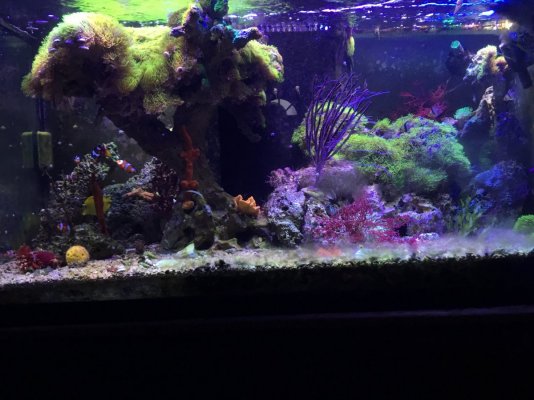So I'm debating whether I want to do a full blown macro algae tank (With gorgs and sponges) or a mixed one with a few easy corals included like leathers, pavona, etc that would add to the scape. My question is what light do you think would help with both? The corals don't have high light requirements so I'm thinking one of the Twinstar lights since I heard those grow macros pretty well. Any syggestions?
Navigation
Install the app
How to install the app on iOS
Follow along with the video below to see how to install our site as a web app on your home screen.
Note: This feature may not be available in some browsers.
More options
You are using an out of date browser. It may not display this or other websites correctly.
You should upgrade or use an alternative browser.
You should upgrade or use an alternative browser.
Lighting suggestion for a mixed macro aquarium?
- Thread starter Northwest_Scapes_
- Start date
- Tagged users None
Some deep water red macros like Bortacladia do not want intense light, yet red Ogo needs much light.
Just like coral, macro can adjust to light.
Just like coral, macro can adjust to light.
It has to be something with full spectrum. That one might work, but I am not familiar with it. It seems to run a little hot to me at a quick glance.
It has to be something with full spectrum. That one might work, but I am not familiar with it. It seems to run a little hot to me at a quick glance.
Why do you say it needs to be full spectrum? Its hard to find research that supports that you need "full" spectrum and most algae cultivating lights tend to be heavy on blue or red (which one of these is more important seems to vary depending on the species and depth).
Why do you say it needs to be full spectrum? Its hard to find research that supports that you need "full" spectrum and most algae cultivating lights tend to be heavy on blue or red (which one of these is more important seems to vary depending on the species and depth).
EDIT: I mean't I have had trouble finding research on wavelength and macroalgae growth other than some are more productive with blue and others red.
Within the current reef tank hobby, there is a propensity to be heavy on blue. I don’t like it for ascetics sake as it washes out yellows & reds of everything in tank.
If you consider the physics of light spectrum, the lower energy spectrum of reds & yellows are filtered out first. There are some deep water macros like Bortacladia, Red Grapes, that grow from 30’-100’ deep. Not much red wavelength there, yet I receive it from divers, it is a dark burgundy and using 10K color rendition can be transformed to fire engine red or even yellow orange with sufficient intensity.
I don’t agree with insufficient research on most efficient choice of light spectrum. There is plenty of research dollars for agriculture on land and 4:1 ratio of red to blue is the clear winner. ATS mimic the research in the reef hobby with great success, but the color rendition to view things sucks.
Here is what 10K looks like. Pardon dirty glass.
If you consider the physics of light spectrum, the lower energy spectrum of reds & yellows are filtered out first. There are some deep water macros like Bortacladia, Red Grapes, that grow from 30’-100’ deep. Not much red wavelength there, yet I receive it from divers, it is a dark burgundy and using 10K color rendition can be transformed to fire engine red or even yellow orange with sufficient intensity.
I don’t agree with insufficient research on most efficient choice of light spectrum. There is plenty of research dollars for agriculture on land and 4:1 ratio of red to blue is the clear winner. ATS mimic the research in the reef hobby with great success, but the color rendition to view things sucks.
Here is what 10K looks like. Pardon dirty glass.
Attachments
Within the current reef tank hobby, there is a propensity to be heavy on blue. I don’t like it for ascetics sake as it washes out yellows & reds of everything in tank.
If you consider the physics of light spectrum, the lower energy spectrum of reds & yellows are filtered out first. There are some deep water macros like Bortacladia, Red Grapes, that grow from 30’-100’ deep. Not much red wavelength there, yet I receive it from divers, it is a dark burgundy and using 10K color rendition can be transformed to fire engine red or even yellow orange with sufficient intensity.
I don’t agree with insufficient research on most efficient choice of light spectrum. There is plenty of research dollars for agriculture on land and 4:1 ratio of red to blue is the clear winner. ATS mimic the research in the reef hobby with great success, but the color rendition to view things sucks.
Here is what 10K looks like. Pardon dirty glass.
I find that most of the research focuses on plants, not algae. They are VERY different in terms of complexity and environmental pressures, therefore you can't apply plant knowledge to algae other than basics such as chlorophyll A.
I find that most of the research focuses on plants, not algae. They are VERY different in terms of complexity and environmental pressures, therefore you can't apply plant knowledge to algae other than basics such as chlorophyll A.
I have been growing macro algae for more than 40 years. At times, I operated > 10K gallons in a 20’ by 40’ greenhouse. I used agricultural & marine engineering data that is available and my experience, but I have written no research papers. Although, I do claim expert status using definition by Norwegian philosopher Niels Bore,
“An expert is someone who has made all the possible mistakes that there are to be made in one field of endeavor.”
Not sure what you mean about the big differences in terms of complexity?
Independent of the complexities of seaweeds; photosynthetic adaptability is a necessary trait of survival for sea plants, seaweeds and corals.
I have been growing macro algae for more than 40 years. At times, I operated > 10K gallons in a 20’ by 40’ greenhouse. I used agricultural & marine engineering data that is available and my experience, but I have written no research papers. Although, I do claim expert status using definition by Norwegian philosopher Niels Bore,
“An expert is someone who has made all the possible mistakes that there are to be made in one field of endeavor.”
Not sure what you mean about the big differences in terms of complexity?
Independent of the complexities of seaweeds; photosynthetic adaptability is a necessary trait of survival for sea plants, seaweeds and corals.
I am not saying you are wrong, I am just wanting to see studies on macroalgae cultivation that suggest greater growth at full spectrum (violet ish -red ish). I do think that it is more efficient to run a wide spectrum if you grow many types of algaes that can have various phosytnehtic pigments.
In terms of complexity, plants often face more extreme environments, with much greater variance in sunlight (particularly if we are comparing tropical algaes in the hobby), greater UV exposure, more nutrient and water insecurity, and more complex bodily functions. What light is used for in plants in terms of internal clocks, photosynthesis, etc. may be very different form the simple single cellular algae that do no contain organs nor highly complex tissues. The ecological pressures between sea algaes that we keep and plants on land that are cultivated can be so extraordinarily different and they have diverged in lineages for hundreds of millions of years to where assuming data used in plant science can be applied to algae is not practical other than comparing the same things like chlorophyll A etc. (of which is sensitive to the blue and red ranges and not green). In fact, unless a plant seems to have a specific photopigment for a certain light condition, it is reasonable to assume that the plant would not need light within the green spectrum (why they do not use green can be explained in the video below). If we want to compare plants and algaes, we can use the knowledge of how plants use certain wavelengths and not others. Plants do not use the full spectrum as they appear to use two ends of the "full spectrum" where they do this to average out the energy to avoid shocks but sudden bursts of one wavelength. So if we use plants as a basis, we should assume that the blue and red are ideal colors. If we are looking at a photosynthetic organism that lives in a dense and shaded area, we could then assume that it may solve the energy balancing problem (in the video) with difference colors of what in reflects and absorbs.
@Spare time
Perhaps you should bring your discussion to @Dana Riddle in lighting forum. My experience is insufficient to support your hypothesis.
Considering vast differences in macro algaes species and also considering abilities of macro algae to photo adapt by shielding with pigments, I doubt you will find
the details you seek.
Good fortune on your quest.
Perhaps you should bring your discussion to @Dana Riddle in lighting forum. My experience is insufficient to support your hypothesis.
Considering vast differences in macro algaes species and also considering abilities of macro algae to photo adapt by shielding with pigments, I doubt you will find
the details you seek.
Good fortune on your quest.
As I researched your threads, I see where Dana told you from his experiences, “intensity is more important for growth than spectrum”.
Last edited:
Most lights out there will grow macroalgae. The difference will be how it looks to your eye.
I personally like full spectrum light. This is my cheap $20 waterproof LED on my 10 gallon macro tank.

and this is my fuge for my 60 with a full spectrum par38

Take a look at these tanks from Tigahboy.

 www.reef2reef.com
www.reef2reef.com
I personally like full spectrum light. This is my cheap $20 waterproof LED on my 10 gallon macro tank.
and this is my fuge for my 60 with a full spectrum par38
Take a look at these tanks from Tigahboy.

Build Thread - Tigahboy's Macroalgae Tank(s)
This is a love story. About a [tigah]boy who fell in love with macroalgae... So I became totally enamored with macroalgae when I added them to a couple of my prior reef tanks (you can find them here in this thread), and I've always been drawn to the freshwater planted tank/scape aesthetic, so...
 www.reef2reef.com
www.reef2reef.com
I also like 10K color rendition for viewing all of my marine tanks.
Even though my experience with 4:1 ratio of red:blue grew abundant macro at most economical cost, I found inability to view macro growth colors interfered with macro health inspections.
Even though my experience with 4:1 ratio of red:blue grew abundant macro at most economical cost, I found inability to view macro growth colors interfered with macro health inspections.
I also like 10K color rendition for viewing all of my marine tanks.
Even though my experience with 4:1 ratio of red:blue grew abundant macro at most economical cost, I found inability to view macro growth colors interfered with macro health inspections.
I just messed around with my hydra on my frag tank and 10k is a really pleasing spectrum!!
I just messed around with my hydra on my frag tank and 10k is a really pleasing spectrum!!
What were you running before 10K?
In general, 5000 Kelvin color rendition simulates noon on a Caribbean reef. If all corals saw that color they would be brown for viewing because pigments to prevent absorption of light spectrum would influence color. Because most reefers don’t want any algae even though corals zooanthelia require photosynthesis they use blue spectrum to discourage nuisance algae. From my observations, I see many nuisance algae threads on blue tanks.
One side note about nuisance algae and deep water Bortacladia. Two months ago, I purchased several clumps of Bortacladia that were all colored dark burgundy. I can not definitely say these macros were just collected in deep water or were they held in a low light intensity system on land. In either case, dark burgundy indicated low light intensity. Some of these Red Grapes have since shown growths of nuisance macros that grew out from surface of Red Grapes: Cotton Candy & GHA in particular.
PS. Red Grapes that grew nuisance algae on macro surface were located near 10K light. The color of Red Grapes shifted from dark burgundy to orange/yellow in places located nearest to light

Last edited:
Similar threads
- Replies
- 4
- Views
- 322
- Replies
- 6
- Views
- 259
- Replies
- 5
- Views
- 236
- Replies
- 1
- Views
- 164


















